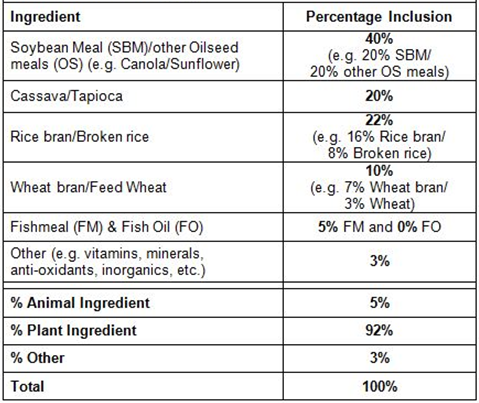Pangasius
Pangasianodon hypophthalmus
Feed
Fish Meal and Fish Oil
Marine ingredients such as Fishmeal (FM) and Fish Oil (FO) provide nutrients that often cannot be found in other feed materials (e.g. particular amino acids, vitamins and minerals), and they are essential constituents of many aquafeeds. FM and FO are a finite resource and are seen by the aquaculture industry as a strategic ingredient to be used efficiently and replaced where possible1.
Globally the FM and FO used in aquafeeds is increasingly derived from fishery and aquaculture processing by-product; the utilisation of these by-products as a raw material for FM and FO production is in the region of 25%-35% and this trend will continue; it is expected to rise to 49% by 20221, 2, 3.
IFFO The Marine Ingredients Organisation4 (formerly known as The International Fishmeal and Fish Oil Organisation or IFFO) estimate that if aquaculture is taken as a whole, producing one tonne of fed farmed fish (excluding filter feeding species) now takes 0.22 tonnes of whole wild fish. This essentially means that for every 0.22kg of whole wild fish used in FM production, a kilo of farmed fish is produced; in other words, for every 1 kg of wild fish used 4.5 kg of farmed fish is produced5.
FM in East and SE Asia is often (but not always) derived from local reduction or ‘trash fish fisheries’, which are sometimes unregulated6, 7. Consequently, traceability and origin of aquatic ingredients is an important factor in the sustainability of pangasius operations. Perhaps the most important mitigation measure is to ensure that products such as FM and FO used to manufacture aquafeed come from legal, reported and regulated fisheries. Such fishery products can demonstrate their sourcing adheres to the United Nation Food and Agriculture Organisation (UN FAO) “Code of Conduct for Responsible Fisheries”8, known as CCRF, through several mechanisms:
- The Marine Stewardship Council (MSC)9 which certifies fisheries to an international standard based on FAO best-practice requirements
- IFFO RS Global Standard for Responsible Supply (IFFO RS)10 which certifies FM and FO through a process which includes the assessment of source fisheries against a set of CCRF-based requirements
- Information platforms such as FishSource11 or FisheryProgress12 which provide information and analysis without a certification or approval rating
Currently around 1.9 million tonnes of FM production is certified as either IFFO RS or MSC – representing about 40% of global production; most of this comes from South America, but Europe and North America are providing significant volumes, and North Africa currently has certified production. Currently there is no certified FM product produced in China and only very small quantities (less than 10,000 tonnes) are produced in the rest of Asia (and this is from by-products)2.Aquaculture certification schemes also require that fish products used in feeds are not on the International Union for Conservation of Nature (IUCN) red lists13 of threatened species or the Convention on International Trade in Endangered Species of Wild Fauna and Flora (CITES)14 lists of endangered species.GM
GM Feed Ingredients
The use of genetically modified (GM) vegetable ingredients in animal feedstuffs (including aquafeed) is an ongoing area of debate15. Whilst some contend that GM soy can help support current levels of aquaculture, global attitudes and consumer perceptions about the use of Genetically Modified Organisms (GMOs) vary in different parts of the world, with North American markets being far less averse than European ones. However, their use in all livestock feed is widespread, and in the EU food from animals fed on authorised GM crops is considered to be as safe as food from animals fed on non-GM crops16.
Pangasius Feed
Careful management of food and feeding regimes are important to the success of aquaculture. To reduce wasting aquafeed on farms, efficient feed use can be monitored and should comply with levels set in certification standards. The indicators used can include the Feed Conversion Rate or FCR (the amount of feed an animal requires to gain a kilogram of body weight), economic feed conversion ratio (eFCR), maximum fish feed equivalence ratio (FFER), or protein efficiency ratio (PER).
The use of commercial pangasius aquafeed in countries such as Vietnam is the norm. In 2012 over 30 companies in the Mekong Delta produced around 1.95 million tonnes of pangasius aquafeed17. A 'typical' pangasius grow-out feed is shown in the table. In terms of feeding efficiency, the average FCR for pangasius is around 1.518.

Plant material inclusion in pangasius aquafeeds is high at over 90%, and ingredients such as rice bran are available in the region, however others such as oilseeds (e.g. soy) and grains have to be imported from other parts of the world18.
Typical pangasius grow-out feeds have low FM inclusion rates of around 5%. Whilst feeds contain relatively little FM, the total volumes used in producing pangasius feeds are significant18. IFFO The Marine Ingredients Organisation estimate that in 2015 for every 0.13 kg of whole wild fish used in FM production for ‘other freshwater fish’ (which includes pangasius) aquafeeds, a kilo of freshwater fish is produced5.
As feed companies constantly develop their aquafeed formulations the decreasing inclusion of marine ingredients will not only continue in pangasius feeds but in those for a number of other aquaculture species.
References
- IFFO
- IFFO
- Seafish
- IFFO
- IFFO
- SFP
- REBYC-II CTI
- FAO
- MSC
- IFFO RS
- FishSource
- FisheryProgress
- IUCN
- CITES
- Sissener, N.H. et al, 2011. Genetically modified plants as fish feed ingredients. Canadian Journal of Fisheries and Aquatic Sciences, 2011, 68(3) p563-574
- FSA
- Merican, Z. and Huong, N.T.M., 2010. Sa Dec – Vietnam’s Pangasius Feed Capital. AQUA Culture Asia Pacific Magazine, Sept.-Oct. issue, 2010, p10-15
- Seafood Watch